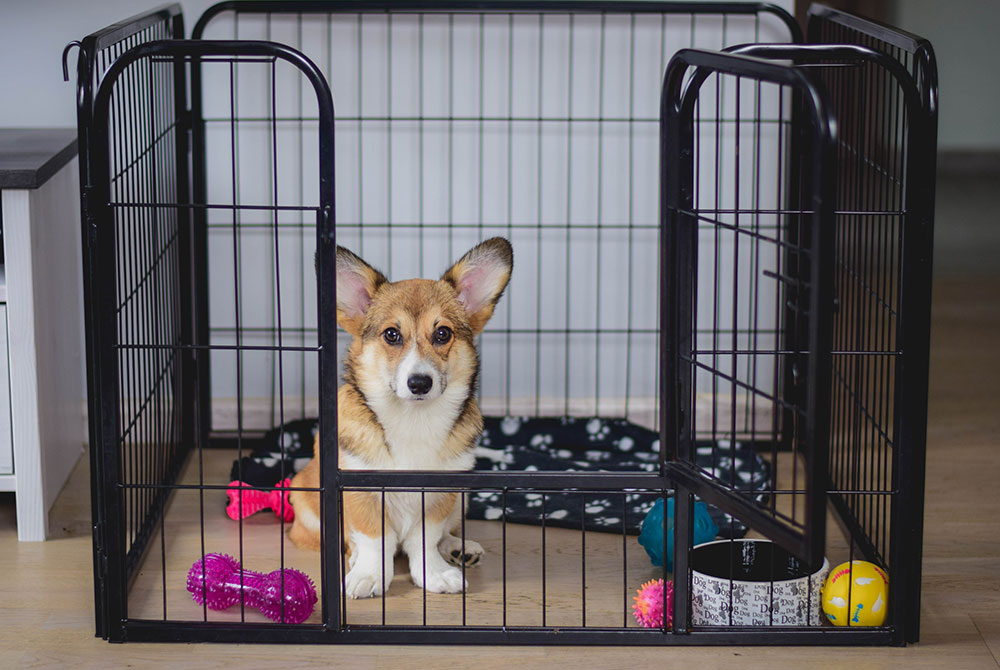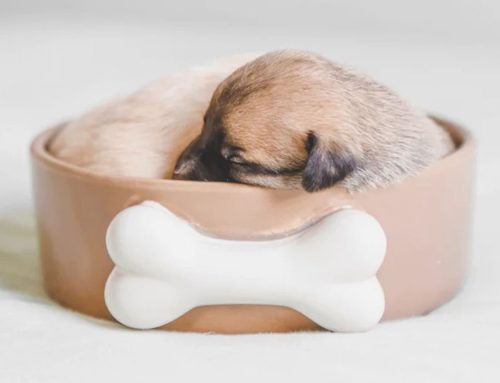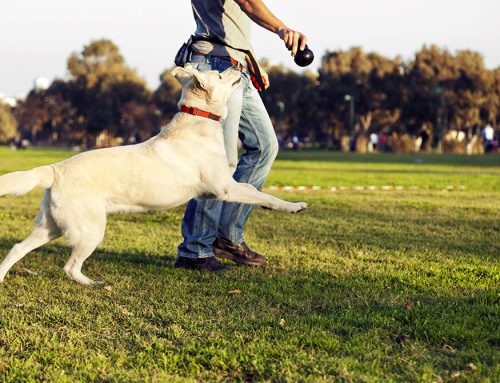© 2010 ASPCA. All Rights Reserved
Some trainers and behaviorists recommend introducing your dog to a new crate very gradually, over a period of a week or more. This method works well for timid dogs who fear confinement and for dogs who have already learned to dislike crates. But many dogs can learn to use crates more easily, and many people just don’t have the time to devote an entire week or more to training before being able to use a crate.
If you need to start using a crate as soon as possible, try the following Weekend Crate Training plan. To successfully use this crate-training plan, you’ll need to follow the directions below, step by step. It’s important to avoid skipping ahead and leaving your dog alone in the crate before she’s ready.
To confine your dog at night over the weekend, put her in a small, safe area instead. You can use an exercise pen or baby gate to block off part of your kitchen, a bathroom or a laundry room. Make sure that the area is dog-proofed and free of things that your dog shouldn’t chew. You can leave her with something comfy to lie on, some water, her toys and some chew things to keep her occupied.
It’s best not to leave your dog home alone at all during the day on Saturday or Sunday. If you must do so for some reason, you can use the same dog-proofed area so as not to deviate from your training plan.
- Preparation: Choosing a Crate
- Comfy Crate
- Friday Night: Before You Start Training
- The Treat Fairy
- Room Service
- Prepare Supplies for Saturday and Sunday
- Saturday Morning: Let the Crate Fun Begin!
- Step One: Follow the Treat
- Step Two: Earn the Treat
- Saturday Afternoon: Close the Crate Door
- Saturday Evening: Introduction to Alone Time
- Sunday Morning: TV Time
Pet supply stores and online vendors sell wire crates, plastic airline crates and mesh crates. Each style has its own advantages. Wire crates usually collapse for easy storage and portability, and they provide more ventilation than plastic ones. Plastic crates seem especially den-like and might make dogs feel safer and more secure when they’re inside. Mesh crates provide privacy for dogs and are the most portable, but they aren’t very durable. Some dogs chew through them and escape.
After choosing which kind of crate to use, it’s important to make the new crate comfortable. Put it in a room where you spend lots of time, but out of the way of foot traffic. Next, put a soft bed or blanket and a toy or two inside. You can even put a shirt you’ve recently worn into the crate so your dog will feel comforted by your scent. (If your dog likes to chew fabric, you can skip this part.) If you purchase a wire crate for your dog, she might like to have a blanket or towel draped over it to create a more “den-like” feel.
The most important part of crate training is teaching your dog to associate her crate with things she loves. Try the ideas below to convince your dog that her new crate is the place to be:
Leave the crate door wide open and make sure your dog has access to the room where you’ve set up the crate. Every so often, when she’s not looking, sneakily toss a few treats around and into the crate so she can discover them on her own. Use something that your dog will love, like small pieces of chicken, cheese, hot dog or freeze-dried liver. You can also leave an exciting new toy, a delicious chew bone or a stuffed KONG® toy inside the crate. Periodically leave special treats in your dog’s crate throughout the evening—and continue to do so every day or so for the next few weeks. If your dog sometimes finds surprise goodies in her crate, she’ll start to love it, and she’ll probably go into it often just to see if the “Treat Fairy” has come.
When it’s dinnertime for your dog, place her bowl inside the crate and leave the door open. Try putting the bowl in the back of the crate so your dog has to stand inside the crate to eat. If she seems too uncomfortable to go into the crate at first, you can put the bowl just inside the door instead. That way, she only has to put her head in the crate. Over time, as your dog becomes more and more comfortable stepping inside, you can move the bowl all the way to the back of the crate and, eventually, close the crate door while she eats her meals.
Over the next couple of days, you’ll reward your dog often for going into her crate. It’s a good idea to prepare some treats in advance. Cut some chicken, cheese, hot dogs, soft dog treats or freeze-dried liver into bite-sized pieces and set them aside for later use. You can also stuff two or three KONGs, which you’ll give your dog when you start to increase the length of time she stays in her crate.
You’re ready to get started. Gather the treats you prepared and take your dog to the crate.
You can do the following exercises sitting on the floor or in a chair right next to the crate. Give a cue to ask your dog to go into the crate, such as “Go to bed.” (Choose whatever cue you like, just be sure you always use the same one.) Show your dog one of the treats and toss it in the crate. After she goes inside to eat it, praise her enthusiastically and feed her another treat while she’s still inside. Say “Okay” to let your dog know she can come out again. You don’t need to reward her when she comes out of the crate. She needs to learn that all good things happen when she’s inside the crate.
Repeat the steps above 10 times. Take a short break (just a few minutes), and then do another set of 10 repetitions. After your second set, end the training session.
Later on in the morning, collect some treats and bring your dog to the crate for more training. Now that she’s practiced following a treat into the crate, try asking her to go in before rewarding her with the treat. To warm up, do a couple of repetitions just like you did before—throwing the treat into the crate so that your dog follows it. Then you can change the rules a little. Give your cue, “Go to bed,” and point to the crate instead of throwing a treat into it. (When you point, it might help to move your arm like you did when tossing a treat into the crate. The familiar motion can remind your dog what she’s supposed to do.) When your dog goes in, praise her and immediately give her a couple of treats while she’s still in the crate.
Say “Okay” and let your dog come out of the crate. Do 10 repetitions and then take a short break. Repeat the exercise another 10 times—or until your dog seems to know the game and enters and exits readily when you ask her to. If your dog seems nervous about going into the crate or confused about what she’s supposed to do when you say the cue, go back and practice Step One for a while longer. When your dog confidently rushes into the crate to get her treat, you can try Step Two again.
Now it’s time to get your dog used to being in the crate with the door closed.
To warm up, do a couple of repetitions just like you did before. Say “Go to bed,” point to the crate, reward your dog with a treat when she goes in and then say “Okay” to let her know she can come out. Now you’ll try closing the crate door for just a moment. Give your cue “Go to bed” and point to the crate.
When your dog goes in the crate, praise her and immediately give her a treat. Then gently close the crate door. (You don’t have to latch it yet.) Feed your dog two or three treats through the closed crate door and continue to praise her while she’s in the crate. Say “Okay” and open the crate door to let your dog come out. (If your dog seems stressed or panicked with the door briefly closed, break down this exercise into two phases: in the first phase, just close the door halfway, give a treat and release your dog; in the second phase, close the door all the way.)
Do 10 repetitions and then take a break for a minute or two. Then repeat the exercise 10 more times, slowly building up the time your dog stays in the crate with the door closed. As you increase the time, throw in some easy repetitions, too. Start with 1 second, then increase to 5. Try 8 seconds, then go back to 3. Increase to 10 seconds, then 15, then 20, then an easy 5. Continue to generously reward your dog whenever she’s in the crate. After you finish your second set of 10 repetitions, take a half-hour break. Then repeat the exercise again. Over the afternoon, try to build up to having your dog stay in the crate for one minute.
When your dog is used to hanging out in her crate with the door closed while you sit nearby, you can move on to the next step: leaving her alone for a little while. Repeat the exercise you’ve been practicing, just as it’s described above—but this time, latch the crate door and start to move away from the crate.
To warm up, do a couple of repetitions like you did in the afternoon. Sit on the floor or in a chair next to your dog’s crate. Say “Go to bed” and point to the crate. When your dog goes in, close the crate door and reward her with a few treats while she stays in the crate. After about 30 seconds, say “Okay” and open the crate door to let your dog out. Now you’ll close the crate door briefly. Say your cue, “Go to bed,” and point to the crate. When your dog goes in, close and latch the crate door, and then give her a treat.
Stand up and give your dog another treat. Take a few steps away from the crate and then return to give your dog a treat. Say “Okay” and open the crate door to let your dog come out.
Repeat the steps above 10 times, each time walking away in a different direction. After a short break, do 10 more repetitions, slowly building up the time your dog stays in the crate while you walk around the room. As you increase the time, throw in some easy repetitions. Start with 10 seconds, then increase to 15. Try 20 seconds, then go back to 10. Increase to 30 seconds, drop to 15, then up to 45, and then an easy 5. Continue to return to the crate and reward your dog every few seconds while she’s inside. In the beginning, be very generous. As your dog becomes more and more comfortable resting in her crate, you can gradually decrease how frequently you treat her.
After you finish your second set of 10 repetitions, take a half-hour break. Then repeat the exercise another 10 times. Start leaving the room for a few seconds at a time, always returning to reward your dog while she’s in the crate. Try to work up to having your dog stay in the crate for one minute while you walk around the room and briefly leave the room.
This morning, you’ll teach your dog to relax for longer periods in her crate. You’ll need some treats, a new tasty chew bone or a KONG toy stuffed with something wonderful, like a little peanut butter or cream cheese, and something to occupy yourself. Ask your dog to go in her crate. When she does, praise her and give her the chew bone or stuffed KONG. Then close the crate door and settle down to watch TV or read a book in the same room. Keep your dog in her crate for about half an hour. (If she finishes her chew, you can periodically give her a treat or two, as long as she stays quiet.)
When the half hour is up, calmly open the crate and say “Okay,” so that your dog can come out. Take her chew thing away, and don’t reward her with treats when crate time is over. In fact, it’s best if you just ignore your dog for a few minutes. Again, you want her to learn that great things happen while

























Leave A Comment